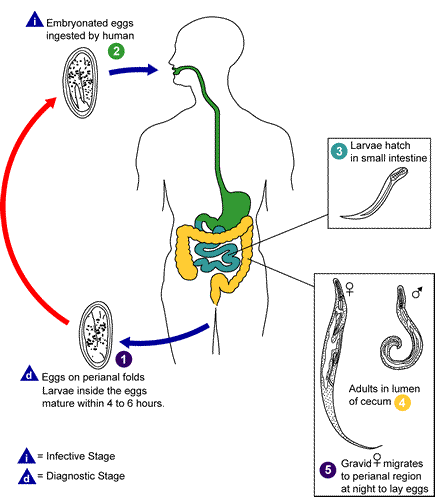Payl:Enterobius vermicularis LifeCycle.gif
Enterobius_vermicularis_LifeCycle.gif (435 × 497 pixels, size sa payl: 17 KB, MIME type: image/gif)
Kaagi sa payl
I-klik ang petsa/oras aron makit-an ang hulagway sa payl niadtong panahona.
| Petsa/Takna | Thumbnail | Mga dimensyon | Tiggamit | Komento | |
|---|---|---|---|---|---|
| kasamtangan | 17:27, 15 Disyembre 2012 |  | 435 × 497 (17 KB) | Cartoffel | watermark removed |
| 18:50, 13 Mayo 2006 |  | 435 × 497 (21 KB) | Patho | {{Information| |Description=Enterobiasis [Enterobius vermicularis] Life cycle of Enterobius vermicularis Eggs are deposited on perianal folds. Self-infection occurs by transferring infective eggs to the mouth with hands that have scratched the peria |
Mga paggamit sa payl
Ang mosunod nga mga panid misumpay niining payl:
Global nga paggamit sa payl
Kining ubang wiki naggamit ning maong payl:
- Paggamit sa ba.wikipedia.org
- Paggamit sa da.wikipedia.org
- Paggamit sa de.wikibooks.org
- Paggamit sa en.wikipedia.org
- Paggamit sa es.wikipedia.org
- Paggamit sa fa.wikipedia.org
- Paggamit sa hy.wikipedia.org
- Paggamit sa lt.wikipedia.org
- Paggamit sa ml.wikipedia.org
- Paggamit sa nl.wikipedia.org
- Paggamit sa pa.wikipedia.org
- Paggamit sa pt.wikipedia.org
- Paggamit sa ru.wikipedia.org
- Paggamit sa szy.wikipedia.org
- Paggamit sa th.wikipedia.org
- Paggamit sa vi.wikipedia.org
- Paggamit sa zh.wikipedia.org


